How To Create A Guide
Chances are if your products are more complex than a roll of paper towels, you create some kind of user documentation to help people learn how to use them.
A well-crafted, user-friendly product manual or user guide can mean the difference between a fantastic customer experience and a terrible one.
And, user documentation isn't just for new users.
Experienced customers may also refer to user manuals or product guides to refresh their memories on a feature they haven't used often or to solve a specific problem they may have.
For this post, we'll focus mostly on best practices for creating user documentation for non-physical products such as software, but most if not nearly all of these tips also apply to the physical product realm.
Here's what you'll learn:
- What is user documentation and why is it important?
- How end user documentation is part of the customer experience.
- How good user documentation can help take the burden off your customer support team.
- Why visual content is the secret ingredient to the best documentation.
- The essential elements that ensure the best user documentation.
- The four steps to creating documentation that delights your customers and stands the test of time.
Easily create a user guide (Free Template)
Snagit's templates are the fastest way to create user guides. Create step-by-step guides with a simple and professional look.
Download
What is user documentation?
User documentation (also called end user manuals, end user guides, instruction manuals, etc.) is the content you provide end users with to help them be more successful with your product or service.
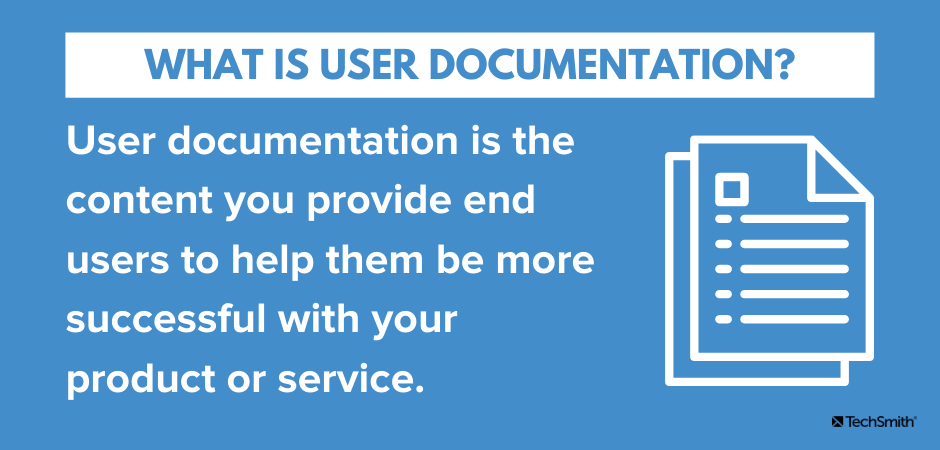
These are the instructional materials that go with your product to help someone learn to properly use it or — in the case of physical products — even put it together.
If you've ever assembled a piece of Ikea furniture, you've used end-user documentation.
But, user documentation takes many forms.
Video games come with manuals to tell you which buttons to push to shoot the bad guys. Software documentation shows you what your purchase can do and how to do it.
Tax forms come with guides on how to properly fill them out.
Lawnmowers and snow throwers have product guides to show you how to start the engines and where to refill the fuel.
Skip down to how to make user documentation
Why is user documentation important?
You know your product is great. You want your customers to know it, too. User documentation helps ensure your customers or users actually learn how to get the most out of your product.
Whether it's how to save a document, start a motor, use a specific tool, or important safety information, your end-user documentation is an important part of your relationship with your customers.
It can delight your customers
User documentation is easy, right? I mean, just write some stuff about how to use your product and you're good to go!
It's not quite that simple.
It's more than just "how-to" material. It's part of the customer experience. And that means it's also marketing material.
As a consumer myself, I've experienced both great and horrible user guides. I bet most of you have had similar experiences.
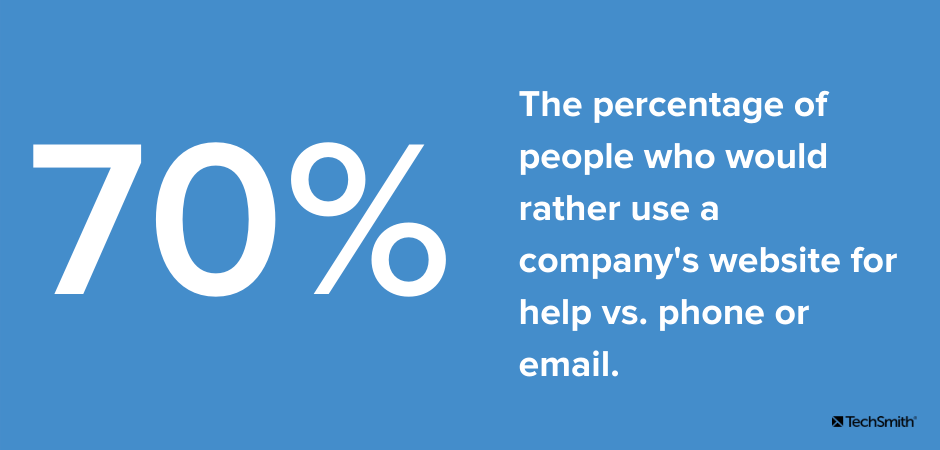
A great user manual or product guide shows your customers that you care not just about whether they buy your product, but whether they have a truly great experience actually using it.
And customers who feel that you care about them beyond their wallet will keep coming back to you.
If you want them to shout to the world about how much they love your products and services, providing awesome user documentation is an essential part of that post-purchase experience.
How user documentation supports your support team
People contact your support team when something isn't working, but they also call when they just can't figure something out. Having great user documentation helps out your support team in two major ways.
1. Gives them an easy reference guide
Great user documentation doesn't just have to be for customers. Your product support team can use documentation to help better support your customers when they call. When you include essential pieces such as a table of contents or index, they can quickly find the information they need. And, if it's a searchable electronic document, that's even better! We'll learn more about this later in the article.
2. Reduces calls
As noted above, people often call support when they can't figure something out. But, if customers can figure it out themselves they're far less likely to need help. In fact, more than 70 percent of people prefer to use a company's website for help rather than use a phone or email.
Now, even the best documentation won't eliminate all of these calls, but creating user guides and manuals that are comprehensive, easy to understand, clear, and concise will go a long way to reduce the overall volume of calls, emails, chats, etc.
What are the essential elements of great user documentation?
Even though each product is unique and will require different elements to create truly great user docs, there are some end user documentation best practices to follow no matter what.
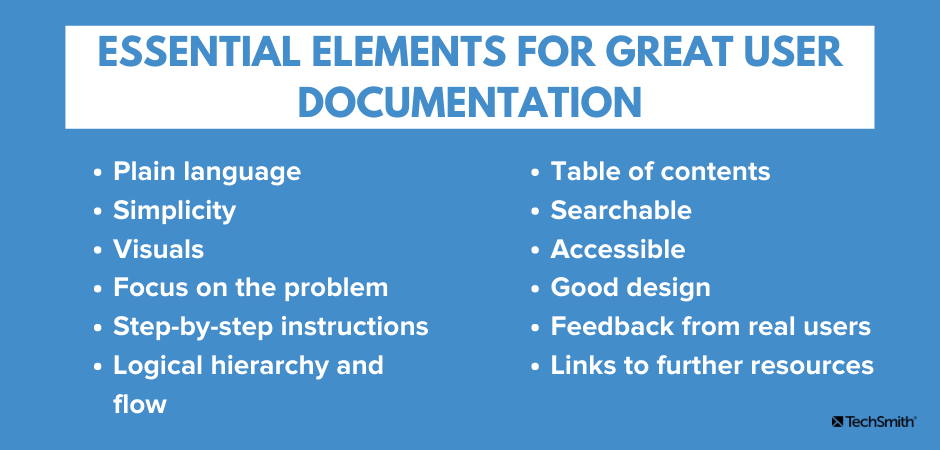
Great user documentation should include:
- Plain language
- Simplicity
- Visuals
- A focus on the problem
- A logical hierarchy and flow
- A table of contents
- Searchable content
- Accessible content
- Good design
- Feedback from real users
- Links to further resources
Plain language
Nothing will frustrate a customer more than reading something they can't understand. No one wants to feel dumb. Making your customer feel that way is certainly no way to foster a great experience.
Use simple, plain language whenever possible to help your customers understand even the most complex concepts.
Remember, write for the user, not the developer.
It sounds like a no-brainer, but writing in plain language about a product or service you know front-to-back is way more difficult than you might think. You know all kinds of jargon, acronyms, and other "insider" info that customers likely don't. It's natural for you to use it.
But that's where you can run into some serious trouble.
Don't assume your customer knows anything about your product. Don't assume they know all the technical and/or industry buzzwords that you likely use every day inside your office. Write it for them.
Don't write as if they're children, but understand that they may need extra help to truly get them up to speed. Write the documentation in an easy-to-read way.
Simplicity
Keep it as simple as possible to achieve its goal. This applies both to the document's content as well as its design. Long blocks of text and pages tightly packed with written and graphic content can make user guides or manuals feel intimidating and unfriendly.
Customers who are intimidated by your user materials are far more likely to call your support team for help than they are to try to solve their questions on their own. And, they're far less likely to have a good customer experience.
Visuals, visuals, visuals
The best user documentation perfectly illustrates the adage, "show, don't tell."
Visual content, including images, annotated screenshots, graphics, and videos, quickly shows someone how your product works. They don't have to read about, they can see it!
Recent research from TechSmith shows that people actually absorb visual information faster and perform tasks better when instructions are provided with visual or video content.
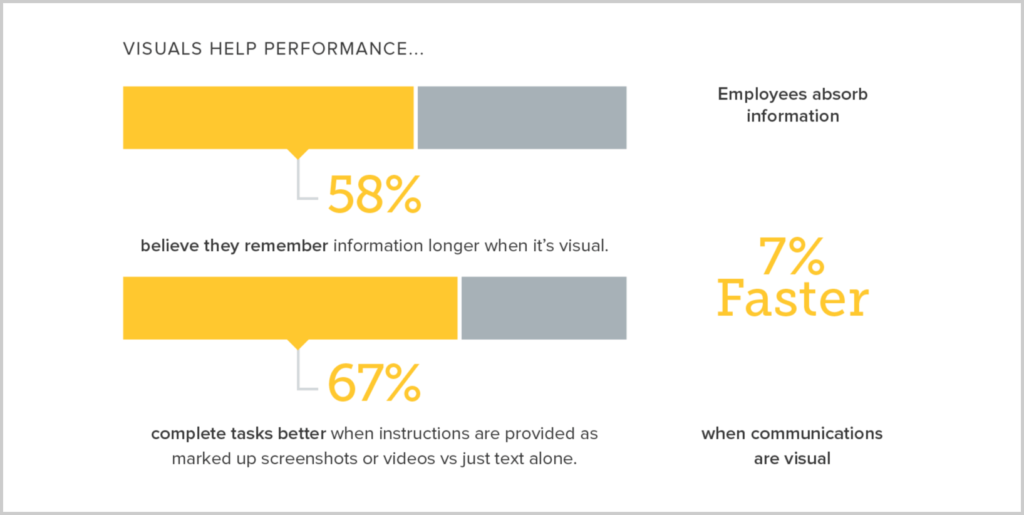
Visual content also helps break up long blocks of text and can help eliminate a lot of the text that can make many user guides or manuals feel intimidating and unpleasant.
Popular ways of including visual content in user documentation include screenshots, screen recordings, tutorial videos, and more.
Have you heard of simplified graphics? Sometimes called simplified user interface (or SUI), simplified graphics take images of a user interface or other graphic and — just as the name suggests — simplifies them. This more basic version highlight the most essential information while reducing text and graphics that aren't important to simpler shapes.
So, something that looks like this:
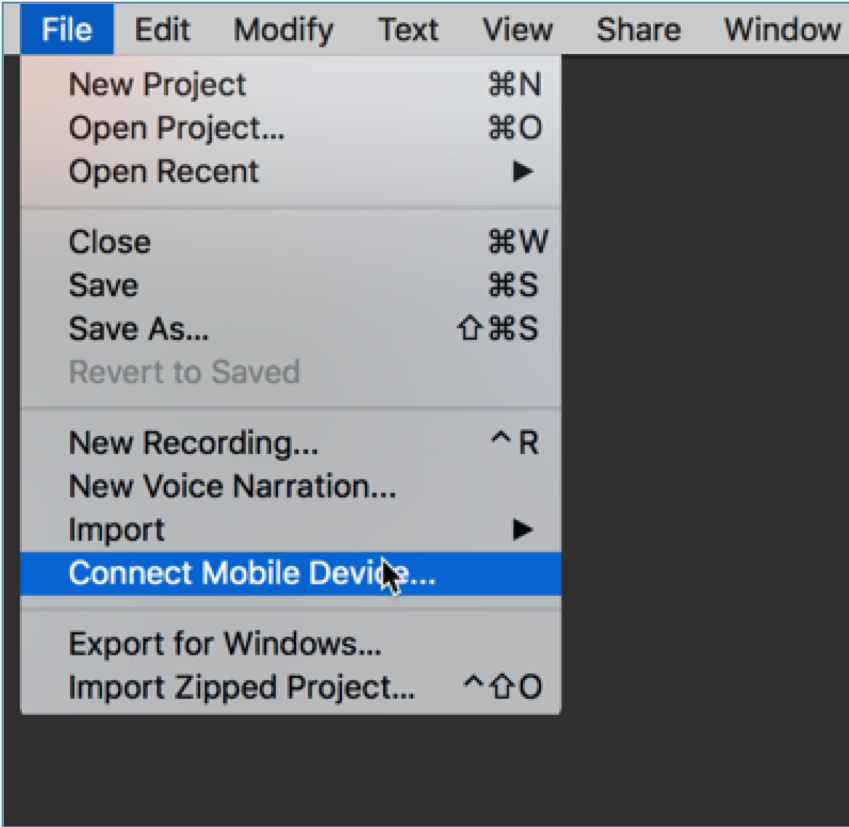
Now looks like this:
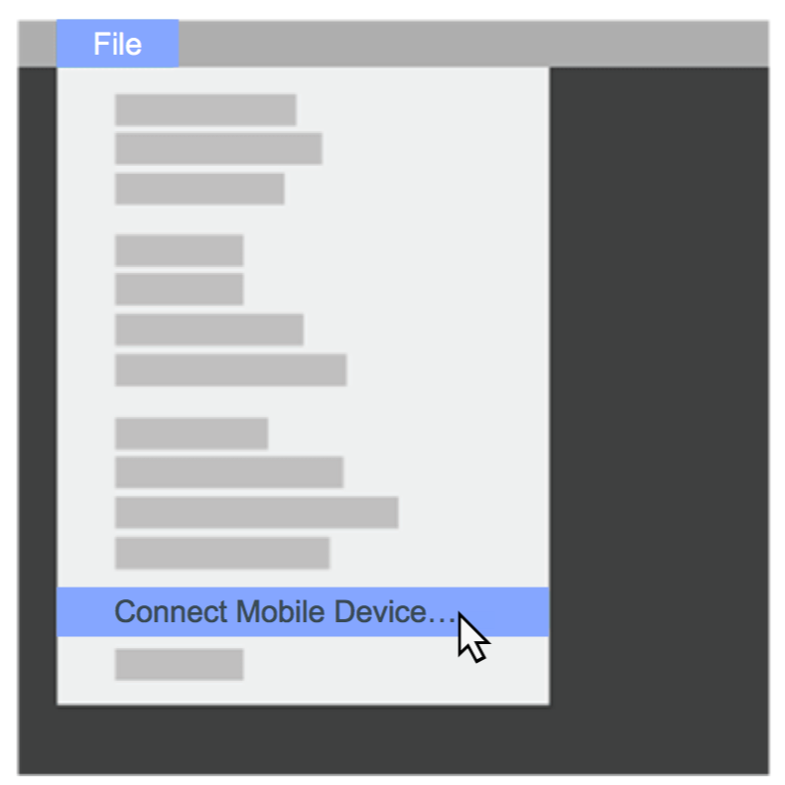
If I were trying to show someone how to select the Connect Mobile Device menu item, the second image removes all the clutter and allows the customer's eyes to focus where they need to be.
Chances are you've already encountered simplified graphics and didn't even realize it.
Like this one from G Suite Learning Center:
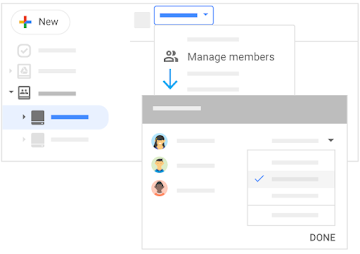
There are a lot of tools out there, but if you're looking for powerful and easy ways to create screenshots and screen recordings, I highly recommend downloading a free trial of Snagit.
Focus on the problem to be solved
Every product solves a problem. But too often, we're so in love our cool product features, all we want to do is highlight what it can do rather that why our customers need it.
Make sure to show users how to perform tasks with your product.
Naturally, this will involve product features, but do so in the context of helping the user get to the reason they bought your product in the first place — to solve a specific problem.
For example, our Camtasia and Snagit tutorials (yes, tutorial videos can be a form of documentation) highlight specific features, but they do so in the context of why someone might use that feature. It's about the why, not just the how.
Here's a great example …
Logical hierarchy and flow
Good documentation needs a hierarchy of headings and subheadings that lets a user know what each section will show them. And that hierarchy should follow a logical flow that helps the user learn to use your product in the most helpful way.
For example, you probably don't want to begin your documentation by showing your customers how to use the more advanced functions without first showing them the basics of how your product works. Start with the easy stuff first and then, as your users build their knowledge, show them the advanced features.
Table of contents
A table of contents provides your customers a simple, efficient, and familiar way to quickly find a solution to their question or problem. It's right at the beginning of the document so they don't have to sift through pages of text to find what they're looking for. It should include all the major headings and subheadings as described above.
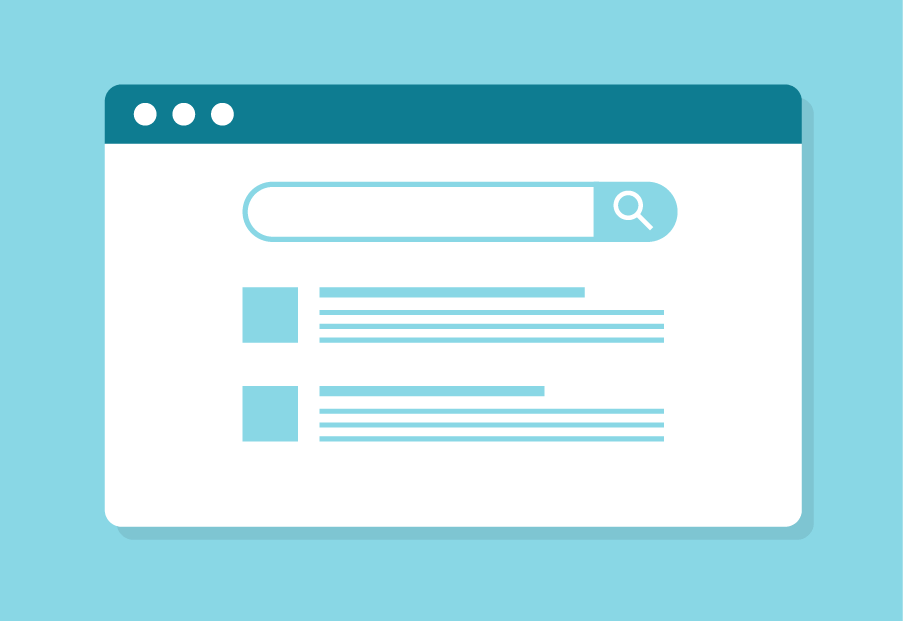
Make it searchable
There was a time when most user documentation was printed. Now, in an era where just about everyone has access to a smartphone, it makes more sense to create electronic documentation. That doesn't mean you can't create print versions, too, but an electronic version offers a number of advantages we'll into in more detail below.
Like a table of contents, searchable content gives users easier access to your content and helps them find solutions on their own.
Accessibility
Create accessible content. This means ensuring that electronic documentation adheres to standards of accessibility for people who may be blind or visually impaired, deaf or hard of hearing, or may have cognitive disabilities.
Remember, many of your customers need this to understand and fully access your user documentation. Don't leave them behind!
Good design
Give your users a document they want to look at and they'll be more likely to use it.
Design materials with your customers in mind. Make it usable and friendly. Avoid long paragraphs of text or pages that are packed too full of content. Allow for white space to help break up the monotony and make the prospect of learning a new product less daunting.
Include graphics and images as much as possible to show rather than tell your customers how to use your product. For electronic documentation, use video and gifs.
Use consistent fonts and complementary colors across multiple documents. If your organization has a style guide (which I HIGHLY recommend you should), make sure your documentation adheres to it.
Snagit templates makes it incredibly easy to create professional-looking user documentation from a series of screenshots or other images. Simply gather the images you need, choose Create and Image from Template and you're on your way.
Snagit comes with a bunch of free, professionally designed templates, and with TechSmith Assets for Snagit, you get access to a ton more!
Feedback from real users and/or beta testers
You can't create truly great user documentation until you've listened to the people outside your organization who actually use the products.
Learn their pain points and try to address them as best you can. Find out what they tell you they need to know to best use your products. While some of it might be obvious, I guarantee you'll learn things you never even considered.
Links to other documentation
Make sure your customers have access to more of your organization's resources on how to be successful with your products. For electronic user documentation, this can be as simple as providing links to tutorials, FAQs, user forums, and more.
But even print documentation can include things like website addresses and phone numbers for further support.
Bonus! Add Step-by-step instructions
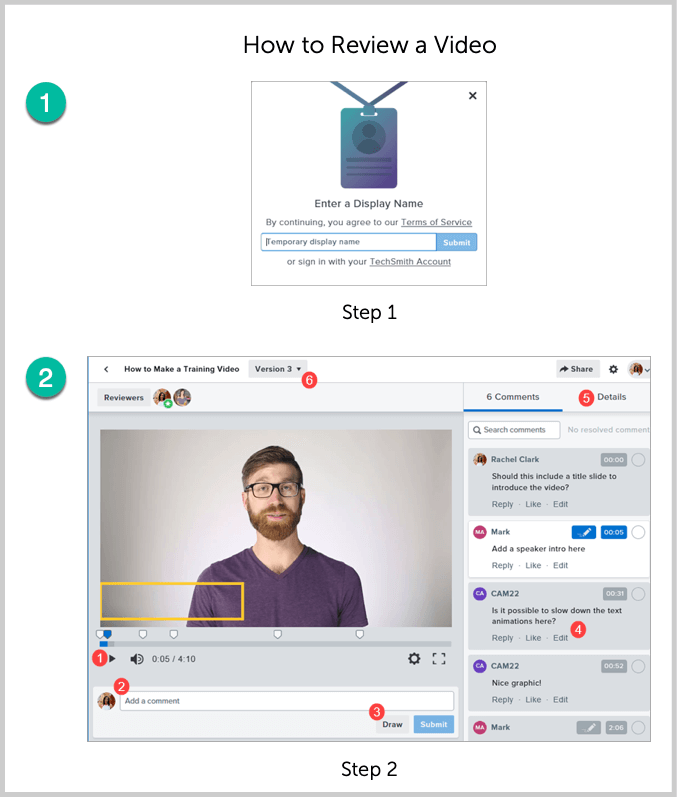
Step-by-step guides help avoid long blocks of text and provide a much clearer way to show a process than trying to explain it via text alone. They're easier to follow, easier to understand, and offer a much more user-friendly experience than simply telling someone how to complete a task.
And remember, including visual content in your step-by-step instructions makes them even better.
Snagit provides a super-easy-to-use Step Tool that helps you create great step-by-step documentation. Plus, the Combine Images Tool enables you to combine individual screenshots and other images into a single image for easier editing and mark up.
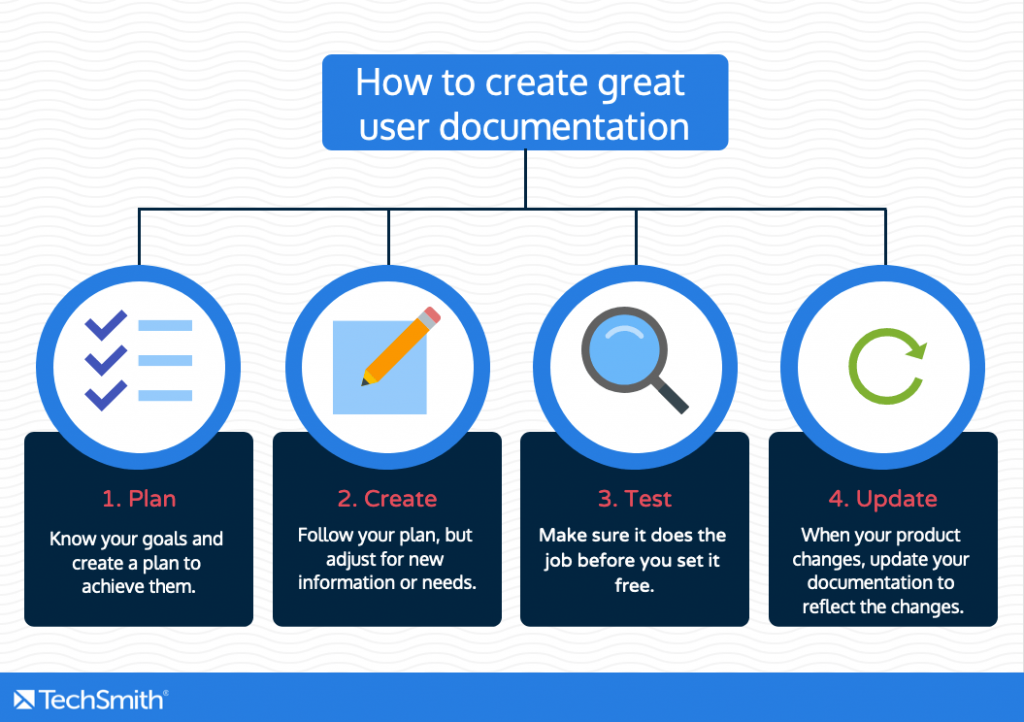
How to create great user documentation
Step 1: Plan
Every great set of user documents starts with a plan. Here are some tips on how to get where you're going.
Know where to start
Many people assume that if you know your product, you can just start creating your documentation, but there's a lot more that goes into it. Instead, start with a plan to ensure that you're actually helping your users.
Before you make documentation, here are a few things to consider:
- What should you include? What should you leave out? (Hint: This is where user feedback can be REALLY helpful!)
- In what order should we present the information? (Remember essay outlines from middle school? Use 'em!)
- What other resources will be available? How will we provide access/links to those?
- Who is responsible for creating the document? Who is responsible for feedback on the document? Who has final approval?
- Will this need to be translated or localized?
The answers to those questions shape how you create your documentation. Planning ensures a smooth process and a better user document.
Know your product
Make sure you know your product.
That doesn't mean you need to be the absolute expert at everything, but anyone creating a user manual or user guide should have hands-on experience with the product.
Rely on your subject matter experts for the more in-depth knowledge, for sure, but you should know how to use it yourself before you try to teach someone else.
Choose your format
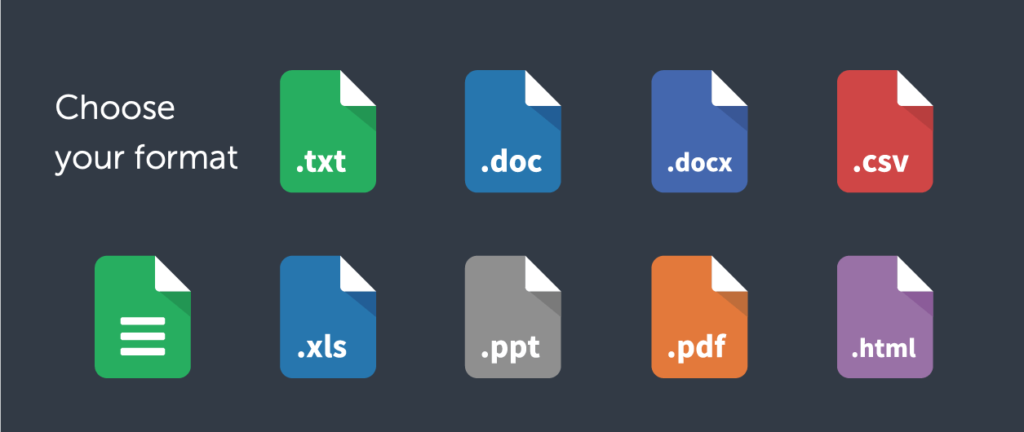
Additionally, a document's final format is equally important. Will it be print-only? Will it be electronic? If so, where will it live?
It wasn't too long ago that nearly all user documentation was print only. But, unless you have a very good reason, I recommend at least having an electronic version available on your website.
Most users have 24-hour access to smartphones, computers, or tablets, and they're used to finding anything they want to know whenever they want to know it. Putting user resources online gives them access wherever they may be, meaning they don't have to go searching through drawers or file cabinets to find a user manual they haven't seen in years.
Also, it's simply easier to make electronic documentation accessible for people with disabilities. A print-only version will work for most people, but are you prepared to create a braille version for users who may be blind or visually impaired? What about users who have a physical disability where it's difficult for them to manipulate objects with their hands?
Tools exist to make electronic documentation easier for all to access, but print-only versions provide a much more difficult accessibility problem.
Plus, electronic documentation is much easier to update, as it lives on the web.
PDF: Should you or shouldn't you?
Unless you want people to print your documentation, do NOT make it a PDF. Instead, make an electronic version available on your website as normal website text. There are a number of reasons for it, but it all boils down to this: It's just easier to use.
If you want to offer a downloadable PDF version of your documentation, that's fine. But make sure it's available on your website in a non-PDF format, as well.
Step 2: Create your user document
Once you've answered all the questions and made all of the decisions outlined above, it's time to create your user documentation. I'm not going to presume to tell you how EXACTLY to create the documentation for your specific product, but there are some key things to keep in mind.
- Avoid jargon and highly technical terms except when absolutely necessary (and then be sure to define them).
- Avoid acronyms unless you explain what they mean.
- Use a commonly recognized writing style such as AP or Chicago whenever possible. If your organization has a company style guide, use that.
- Don't assume the user knows anything about your product or what it does. SHOW them what they need to know to be successful.
- Remember to use plain language. Write for an eighth-grade level. Even for advanced readers, simple language leads to faster processing and better comprehension.
- The design should be pleasing, non-intimidating, and draw the user in. Make them WANT to use your documentation.
Step 3: Test it
A user guide is only great if it helps your customers use your product to the best of their ability. And you can't know that until someone uses it. Before your new creation goes out into the world at large, you want to test it. Here are a few tips!
- Best practice: Give it to a group of real users or beta testers and see how they do. Incorporate their feedback into the finished document.
- If you don't have beta testing user feedback, test it internally, preferably with employees who are least familiar with the product.
- Get feedback from the developers and engineers. They know the product better than anyone and they can point out things you may have missed.
Step 4: Keep your documentation up to date
When your product changes, you'll need to everything up to date. As noted above, this gives electronic documentation a huge advantage over print. However, even print-only docs can be updated and made available for download on your website.
Remember, your content is only great if it's accurate. Be sure that what you give your customers actually helps them use your product.
Summary
If you remember nothing else, keep in mind that great user documentation should be created, designed, and presented in a way that is most helpful to your users.
Give them documentation that continues to delight them and provides the kind of customer experience you'd want to have.
Make your documentation accessible, useful, make it visual.
Easily create a user guide (Free Template)
Snagit's templates are the fastest way to create user guides. Create step-by-step guides with a simple and professional look.
Download
Frequently ask questions
What is user documentation?
User documentation (also called end user manuals, end user guides, instruction manuals, etc.) is the content you provide end users with to help them be more successful with your product or service.
What are the types of user documentation?
In the past, user documentation was given via a help file that was local to the user's machine or a physical manual or booklet. Nowadays, user documentation is almost always offered online, which has helped technical writers be more imaginative in how they assist users.
What is included in user documentation?
Great user documentation should include: Plain language, simplicity, visuals, a focus on the problem, a logical hierarchy and flow, a table of contents, searchable content, accessible content, good design, feedback from real users, and links to further resources.
How do you create a user document?
Great user documentation can be made in four simple steps: First Know your goals and create a plan to achieve them. Next, create
your guide based on your plan. Then test out your guide to make sure it does the job before you set it free. Finally, keep it up to date. When your product changes, update your documentation to reflect the changes.
Note: This post was originally published in August 2019, but was updated in September 2020 for clarity and to include new information.
How To Create A Guide
Source: https://www.techsmith.com/blog/user-documentation/
Posted by: carsonarring1990.blogspot.com

0 Response to "How To Create A Guide"
Post a Comment